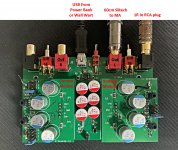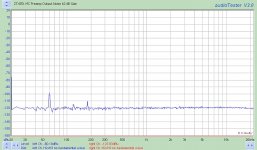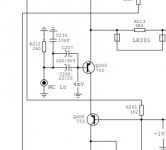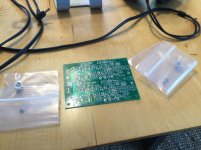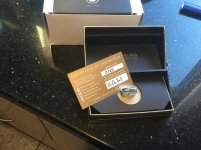I had originally similar figures as you just showed, but after extensive searching this showed to be caused by the Nichicon supply caps.
By replacing them by Panasonic 105C FM caps the problem was completely solved.
What type/series of Nichicons were changed to FM, if I may?
This is a picture taken from the 3.9mF Nichicon Aluminium Polymer caps causing the trouble.
https://nl.mouser.com/datasheet/2/293/e_plg-2400586.pdf
Hans
.
https://nl.mouser.com/datasheet/2/293/e_plg-2400586.pdf
Hans
.
Attachments
I also think that when trying to cram almost 4000uF in such a minuscule can, low noise would not be a priority.
Jan
Jan
Yes, they are even supposed to be a factor 5 better in leakage as the Panasonic FM.
Thx for finding them.
Hans
Thx for finding them.
Hans
This are the lowest leakage Elcaps I could find.
This is what Wayne Kirkwood measured with 1R between emitters in the image below, in the same Cohen setup as you have chosen for a pre-pre.
Also here no sign of 1/f noise, measured EIN of -141.06dBu with 10R source and in this case with the ZTX851.
This -141.06dBu@20Khz BW is ca 0.49nV/rtHz, translating into 0.27nV/rtHz with shorted input.
Looking forward to see your noise measurements.
Hans
Attachments
I am Building the Kirkwood Too. I have ordered PCBs for this. I have some buggs in my own Design and Not much Time to find them.
Thanks for the order Joachim!
I should probably do a post in the Test Equipment forum about the Vbe matcher I use for the ZTX851. It may be useful to other people for matching more than preamp inputs. I'll give it a go here and see what you think.
Transistor Vbe Matching Using A Commutating Chopper-Based Circuit - Pro Audio Design Forum

It's a commutating version of Ian Fritz' design where the relative Vbe-mismatch is displayed as an AC component. The AC output can be measured with either an oscilloscope, a sound card or both.
Until a pair stabilizes its moving. Making the display an AC component reduces the tedium of watching a constantly-moving DC value on a DVM.
This is a pair with an approximate 500 µV match.
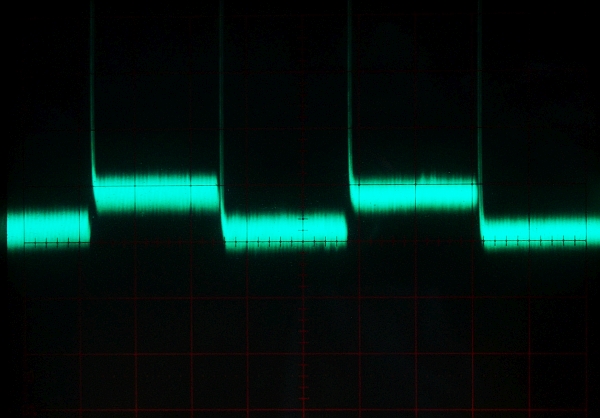
The ZTX851 Vbe-match fairly easily. It's not unusual to be able to pair-match 8 out of 10 to <1 mV.
When Vbe-matched Hfe is usually very close with the ZTX851.
I have yet - knock on wood - found a noisy one.
Once they're assembled onto the board an aluminum acorn cap nut is expoxied to provide thermal mass and thermal equalization.
These particular caps are stainless but aluminum is what I now use.

You can definitely observe a reduction in servo activity when the ZTX851 are wearing hard hats.
Flat Balanced Input Moving Coil Phono Preamp Construction Information - Page 3 - Pro Audio Design Forum
For those concerned about the low gain of the ZTX851 they usually run around 140-180. There are others in the ZTX e-Line that have much higher gain with only a slightly higher rbb'. I have a series of threads where I rank them.
The "big daddy" for low noise is the PNP ZTX951. FWIW it's quieter than the 2SB737 (with documented lineage) that I do happen to stock.
We should all be amused that one of the applications note suggestions for the ZTX851/951 was a bridge driver for an auto horn.
Thanks to Horowitz and Hill we've re-purposed auto horn drivers as low-noise preamps. There's an irony in that.
I should probably do a post in the Test Equipment forum about the Vbe matcher I use for the ZTX851. It may be useful to other people for matching more than preamp inputs. I'll give it a go here and see what you think.
Transistor Vbe Matching Using A Commutating Chopper-Based Circuit - Pro Audio Design Forum

It's a commutating version of Ian Fritz' design where the relative Vbe-mismatch is displayed as an AC component. The AC output can be measured with either an oscilloscope, a sound card or both.
Until a pair stabilizes its moving. Making the display an AC component reduces the tedium of watching a constantly-moving DC value on a DVM.
This is a pair with an approximate 500 µV match.

The ZTX851 Vbe-match fairly easily. It's not unusual to be able to pair-match 8 out of 10 to <1 mV.
When Vbe-matched Hfe is usually very close with the ZTX851.
I have yet - knock on wood - found a noisy one.
Once they're assembled onto the board an aluminum acorn cap nut is expoxied to provide thermal mass and thermal equalization.
These particular caps are stainless but aluminum is what I now use.

You can definitely observe a reduction in servo activity when the ZTX851 are wearing hard hats.
Flat Balanced Input Moving Coil Phono Preamp Construction Information - Page 3 - Pro Audio Design Forum
For those concerned about the low gain of the ZTX851 they usually run around 140-180. There are others in the ZTX e-Line that have much higher gain with only a slightly higher rbb'. I have a series of threads where I rank them.
The "big daddy" for low noise is the PNP ZTX951. FWIW it's quieter than the 2SB737 (with documented lineage) that I do happen to stock.
We should all be amused that one of the applications note suggestions for the ZTX851/951 was a bridge driver for an auto horn.
Thanks to Horowitz and Hill we've re-purposed auto horn drivers as low-noise preamps. There's an irony in that.
Last edited:
True. H&H don't deserve all the credit perhaps they can be credited for rediscovery. I've seen them in older Amek consoles.
Zetex recognized their LN properties in 1996: Moving Coil Phono Head Amp, Zetex AN-23, March 1996. - Pro Audio Design Forum
Zetex recognized their LN properties in 1996: Moving Coil Phono Head Amp, Zetex AN-23, March 1996. - Pro Audio Design Forum
WRT to the Linn Linto.
Where is the bias resistor for Q203's base?
Perhaps you are meant to chose a resistor that drops about 4mV ?
Another observation - no protection diode on the base-emitter junction to prevent reverse biasing during power up and down transients...
Schematic came from here :
Linn "LINTO" MC Preamp Schematic without SMPS - Schematic for SMPS wanted
"Tief" could be asked for a correction.
Linn "LINTO" MC Preamp Schematic without SMPS - Schematic for SMPS wanted
"Tief" could be asked for a correction.
